
Multiple Bonds Between Metal Atoms / 03-Chromium Compounds
.pdf
3
Chromium Compounds
F. Albert Cotton,
Texas A&M University
3.1Dichromium Tetracarboxylates
Chromium is unique among the elements of the first transition series in its ability to form many compounds with multiple bonds in Cr24+ complexes. While many if not all of these can be formally called quadruple bonds, in the sense that they entail one μ, two / and one β interaction, the strengths of these bonds, as evidenced by the Cr–Cr distances, vary widely. The Cr–Cr distances range from about 1.83 Å to about 2.60 Å, all within a generally similar geometrical arrangement (paddlewheel) of ligands. Needless to say, this extraordinary variation has been the subject of a great deal of theoretical activity, and will be given attention later in this chapter.
3.1.1 History and preparation
We begin with the Cr2(O2CR)4 compounds since they are, by far, the longest known. In Section 1.2.3 the early (1844) discovery of hydrated chromium (II) acetate, Cr2(O2CCH3)4(H2O)2, by Peligot and the extension of this work to the preparation and (nonstructural) characterization of a large number of similar compounds with other carboxylic acids, especially by Herzog and Kalies, were mentioned. In more recent years additional compounds have been made, but the most significant advances have been the structural characterization of over 40 of these compounds since 1970, and the recent (2000) crystallographic characterization of a Cr2(O2CR)4 molecule with no axial ligation and a supershort bond (1.966 Å).
It will be convenient to have in mind from the outset that the vast majority of tetracarboxylate compounds have the types of structure shown in Fig. 3.1. The axial positions are filled either by separate ligands L or by the oxygen atoms of other Cr2(O2CR)4 molecules. In the latter case infinite chains are built up. A list of structurally characterized tetracarboxylate compounds is presented in Table 3.1.
Dichromium tetracarboxylato compounds are generally air-sensitive, especially in solution, and they must be prepared and handled in an inert atmosphere. Today, nitrogen or argon would be used. Peligot, working at a time when the laboratory staples of today were not available (and for argon, not even known), used CO2.1
35

36Multiple Bonds Between Metal Atoms Chapter 3
Peligot made the acetate by the addition of NaO2CCH3 in approximately the stoichiometric quantity, to a fairly dilute aqueous solution of CrCl2, obtaining an immediate precipitate of the slightly soluble hydrated acetate:
2Cr2+(aq) + 4CH3CO2– + 2H2O = Cr2(O2CCH3)4(H2O)2(s)
By heating this deep-red hydrate for about two hours at 100-110 °C, the brown, noncrystalline, anhydrous material can be obtained. Peligot’s method is presented in full contemporary detail in Inorganic Syntheses2 and Brauer’s Handbuch.3
Table 3.1. Structures of dichromium tetracarboxylates
R |
L |
Cr–Cr (Å) |
Cr–L (Å) |
ref. |
|
|
A. Cr2(O2CR)4L2 |
|
|
|
|
H |
H2Oa |
|
2.373(2) |
2.268(4) |
4 |
|
|
|
2.360(2) |
2.210(6) |
4 |
H |
py |
|
2.408(1) |
2.308(3) |
14a |
H |
HCO2- |
|
2.451(1) |
2.224(2) |
14a |
H |
4-NMe2-py |
|
2.443(1) |
2.270(4) |
44 |
H |
4-CN-py |
|
2.385(3) |
2.34[1] |
44 |
CH3 |
CH3CO2H |
|
2.300(1) |
2.306(3) |
13 |
CH3 |
H2O |
|
2.362(1) |
2.272(3) |
5 |
CH3 |
piperidine |
|
2.342(2) |
2.338(7) |
13 |
CH3 |
pyridine |
|
2.369(2) |
2.335(5) |
6 |
CH3 |
(pyrazine)2/2b |
|
2.295(5) |
2.314(10) |
6 |
CH3 |
4-CN-py |
|
2.315[2] |
2.327[4] |
44 |
CH3 |
4-NMe2-py |
|
2.411(1) |
2.279(4) |
44 |
CH3 |
CH3CN |
|
2.389(2) |
2.326(3) |
39 |
2,4,6-(Me2CH)3C6H2 |
CH3CN |
|
2.395(1) |
2.326(6) |
39 |
CF3 |
Et2O |
|
2.541(1) |
2.244(3) |
14a |
Ph |
PhCO2H |
|
2.352(3) |
2.295(7) |
14a |
2-phenyl-Ph |
THF |
|
2.316(3) |
2.275(6) |
35 |
9-anthracenyl |
(CH3OCH2CH2OCH3)2/2 |
|
2.283(2) |
2.283(5) |
14a |
Oc |
H2O |
|
2.214(1) |
2.300(3) |
13 |
OCMe3 |
THF |
|
2.367(3) |
2.268(7) |
7 |
CMe3 |
pyridine |
|
2.359(3) |
2.325(8) |
44 |
CMe3 |
4-NH2-py |
|
2.379(1) |
2.282(2) |
44 |
CMe3 |
4-CN-py |
|
2.335(1) |
2.334(2) |
44 |
CMe3 |
2-CN-py |
|
2.327(1) |
2.388(4) |
44 |
NEt2 |
Et2HN |
|
2.384(2) |
2.452(8) |
8 |
CH2NH3+ |
Cl |
|
2.524(1) |
2.581(1) |
9 |
CH2NH3+ |
Br |
|
2.513(1) |
2.736(1) |
9 |
C2H5 |
NCS |
|
2.467(3) |
2.249(3) |
21 |
CPh3 |
Et2O |
|
2.303(4) |
2.30(1) |
36 |
CPh3 |
½pyridine |
|
2.383(4) |
2.31(4) |
36 |
CPh3 |
(C6H6)2/2 |
|
2.256(4) |
3.299(2)d |
36 |
CPh3 |
(1,4-F2C6H4)2/2 |
|
2.176(3) |
3.388(2)d |
36 |
CPh3 |
(1,4-Me2C6H4)2/2 |
|
2.291(3) |
3.310(2)d |
36 |
CClH2/CH3 |
pyridine |
|
2.367(2) |
2.336(6) |
44 |
CClH2 |
4-CN-py |
|
2.408(4) |
2.23(2) |
44 |
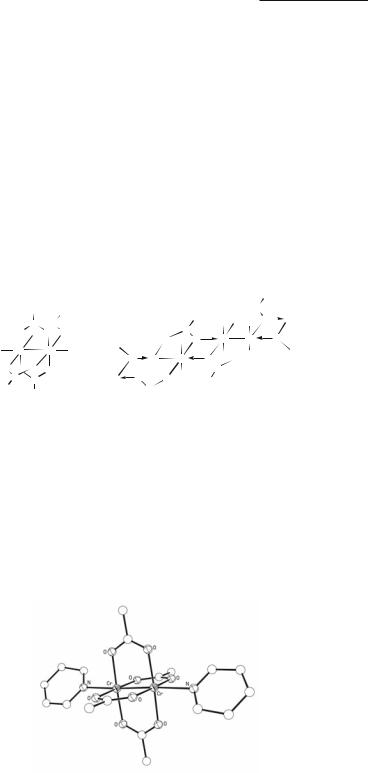
Chromium Compounds 37
|
|
|
|
Cotton |
R |
L |
Cr–Cr (Å) |
Cr–L (Å) |
ref. |
CF2H |
4-NMe2-py |
2.500(1) |
2.246(9) |
44 |
CF2H |
4-C(CH3)3-py |
2.514(1) |
2.299(9) |
44 |
CpFe(CO)2CH2 |
CpFe(CO)2CH2CO2H |
2.307(1) |
2.246(2) |
10 |
|
B. Chains of Cr2(O2CR)4 moleculese |
|
|
|
CH3 |
– |
2.288(2) |
2.327(4) |
34 |
C(CH3)3 |
– |
2.388(4) |
2.44(1) |
14 |
2-PhC6H4 |
– |
2.348(2) |
2.309(5) |
35 |
|
C. Bare Cr2(O2CR)4 molecules |
|
|
|
CH3 |
– |
1.966(14) |
– |
37 |
2,4,6-(Me2CH)3C6H2 |
– |
1.9662(5) |
– |
39 |
a There are two crystallographically independent Cr2(O2CH)4(H2O)2 molecules in the cell. b Notation indicates one axial ligand connects Cr2(O2CR)4 molecules.
c The bridging ligands are carbonate ions. d Cr to ring center. See text.
e See Fig. 3.1.
|
|
|
|
|
|
|
|
|
|
|
|
R |
||
|
|
R |
R |
|
|
|
|
|
R |
|
|
C |
||
|
|
|
|
|
|
|
|
|
O |
O |
|
Cr |
||
|
|
C |
C |
|
|
|
|
C |
|
|
||||
|
|
|
|
|
|
|
|
|
||||||
|
|
|
|
|
|
|
|
|
|
|
|
|||
|
O |
O |
O O |
|
|
|
O |
O |
Cr |
Cr |
|
O |
||
|
|
|
|
|
|
|
|
|
||||||
L |
Cr |
|
Cr |
L |
O |
|
|
Cr |
O |
|
O |
|
|
|
O |
|
O |
|
|
Cr |
|
|
|
|
|||||
O |
O |
|
|
|
|
|
|
C |
|
|
|
|
||
R |
C |
C |
|
Cr |
O |
|
O |
|
R |
|
|
|
|
|
|
R |
|
|
|
C |
|
|
|
|
|
|
|
||
|
|
|
|
|
|
|
|
|
|
|
|
|
|
|
|
|
|
(a) |
|
R |
|
|
|
|
(b) |
|
|
|
|
Fig. 3.1. (a) The general structure of a Cr2(O2CR)4L2 molecule. (b) The formation of infinite chains of Cr2(O2CR)4 molecules by oxygen bridge bonding. Above and below each Cr2 unit are two more RCO2 groups not fully shown.
Quite similar methods have been used for the preparation of other Cr2(O2CR)4 compounds,2,3,11,12 often with the use of ethanol rather than water as a solvent for the longer-chain fatty acids and their sodium salts. As with the acetate, the initial products are hydrates or ethanolates that can be easily desolvated by heating in vacuum. By recrystallization in the presence of donor ligands L or using such ligands as the solvent, a great variety of Cr2(O2CR)4L2 products may easily be prepared,11 for example, the piperidine diadduct13 of the acetate, whose structure is shown in Fig. 3.2.
Fig. 3.2. The structure of the dipiperidine adduct of dichromium tetraacetate.
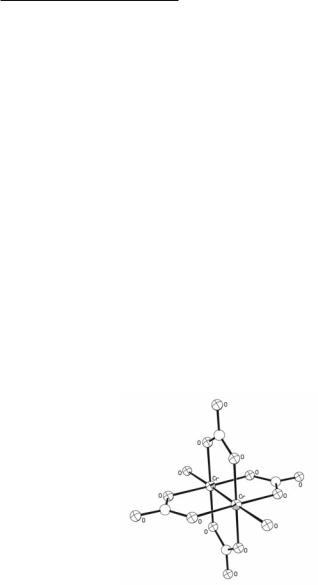
38Multiple Bonds Between Metal Atoms Chapter 3
Other methods of preparation14 have been introduced, based on the idea of displacing the anion of a weak acid from a dior mononuclear CrII complex. One method uses the dichromium tetracarbonato anion (to be discussed in more detail below) and the other employs the /-com- plex (δ5-C5H5)2Cr.
[Cr2(CO3)4]4– + 4CF3CO2H + 4H+ = Cr2(O2CCF3)4 + 4H2O + 4CO2 2(δ5-C5H5)2Cr + 6PhCO2H = Cr2(O2CPh)4(PhCO2H)2 + 4C5H6
Reactions of acids with (δ5-C5H5)2Cr do not always lead to the Cr2(O2CR)4 product. In the case of CF3CO2H, a complex, mixed-valence compound, (δ5-C5H5)CrIII(µ-O2CCF3)3CrII-
(µ-O2CCF3)3CrIII(δ5-C5H5), was obtained.15 A method16 which has not been widely used but may have merit in selected cases, involves treatment of CrCl3 in THF with NaBH4, extraction of the blue product into benzene, and addition of a benzene solution of the carboxylic acid. The products are the THF adducts, Cr2(O2CR)4(THF)2. Chromium(II) acetate, either as the hydrate or in anhydrous form, is widely used as a convenient starting material for the preparation of many other CrII compounds.
It is convenient to mention here the [Cr2(CO3)4]4– ion, which has been isolated in yellow hydrated salts of Li+, Na+, K+, Rb+, Cs+, NH4+, and Mg2+. The earliest work was done around the turn of the century by Baugé,17 but the modern work of Ouahes and cowork- ers18-20 should be consulted for details concerning the preparation18 and for characterization.19,20 X-ray studies of the magnesium19 and ammonium13 salts have shown the presence of dinuclear [Cr2(O2CO)4(H2O)2]4- ions (see Fig. 3.3) very similar in structure to the Cr2(O2CR)4(H2O)2 molecules in hydrated carboxylates, but with a significantly shorter Cr–Cr bond.
Fig. 3.3. The structure of the [Cr2(O2CO)4(H2O)2]4– ion found in the ammonium salt.
3.1.2 Properties of carboxylate compounds
From the earliest days it was reported that Cr2(O2CR)4(Lax)2 compounds display weak paramagnetism (typically corresponding to 0.3-0.5 BM). In some cases at least part of this may be due to impurities, probably CrIII. In several cases where the Cr–Cr distances are long there is also evidence that the Cr24+ unit displays genuine paramagnetism of its own, attributable to thermal population of a paramagnetic excited state.21,22 There are several possible specifications of the nature of this excited state.
In 1992 this question was fully investigated.23 It was recognized that if the singlet-triplet gap is sufficiently small relative to kT at room temperature, it will cause anomalous tempera-
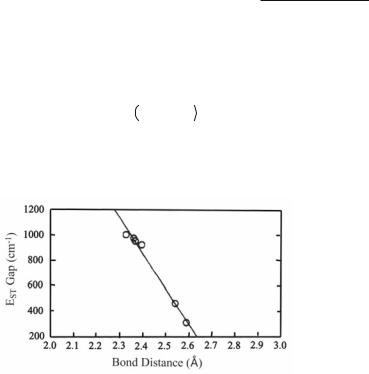
Chromium Compounds 39
Cotton
ture dependence of the 1H NMR spectrum, according to the equation below, in which EST is the energy difference between a triplet state and the ground singlet state, ¨ is the shift in the magnetic field at which resonance is actually observed (at a fixed frequency), C is a collection of fundamental constants, A is the hyperfine coupling constant, T is the temperature (K).
6 = CAkT 3 + eEST/kT -1
By fitting data to this equation at various temperatures, EST values were obtained for several Cr2(O2CR)4L2 compounds. When these are plotted against the Cr–Cr distance, a good linear relationship is found, as shown in Fig. 3.4.
Fig. 3.4. Plot of the singlet-triplet gap (EST) for some Cr2(O2CR)4L2 compounds.
Because the acetate has been widely employed as an aqueous reductant, its kinetic and equilibrium properties in aqueous states have been extensively studied. Cr2(O2CCH3)4(H2O)2 is not very soluble in water, but solutions up to at least 10 mM are obtainable, and the binuclear structure found in the solid persists in solution; the visible spectra of solutions in water (and other solvents) closely resemble the spectrum of the solid.24-26 It has been shown that the important equilibria in aqueous solution (25 °C, ionic strength 1.0 mol/liter of NaClO4) are the following:
Cr2(O2CCH3)4 = 2Cr(O2CCH3)2 |
pK = 4.35 |
Cr(O2CCH3)2 = Cr(O2CCH3)+ + CH3CO2– |
pK = –0.8 |
Cr(O2CCH3)+ = Cr2+ + CH3CO2– |
pK = –0.9 |
It is also known that Cr2(O2CCH3)4 is soluble in acetic acid where it is also predominantly in the dinuclear form and, not surprisingly, this continues to be true in mixed H2O/CH3CO2H solvents, for some of which the dissociation constant has been evaluated.27
In aqueous solution to which other ligands are added, Cr2(O2CCH3)4(H2O)2 can react simply by having these ligands, e.g., SCN–,21 N2H4,28 replace the axial water molecules, or it may react more extensively, as with polydentate ligands,29,30 to give mononuclear products. The rate-determining step for these cleavage reactions is the dissociation of the dinuclear Cr24+ to a mononuclear species, for which the rate constant at 25 °C in 1.0 M NaClO4 is 505 ± 10 s–1.
There has also been a study of the chromium(II) ion in aqueous formate solution,31 from which it was concluded that the following equilibrium occurs:
2Cr(O2CH)+ + HCO2– = Cr2(O2CH)3+ |
K = (2.9 ± 0.2) M–2 |

40Multiple Bonds Between Metal Atoms Chapter 3
As in the previously mentioned reaction of Cr2(O2CCH3)4 with EDTA and other polydentate reagents, the rate laws29,32 are indicative of a mechanism in which dissociation plays a key role. In a few reactions (e.g., with [Co(NH3)5Cl]2+ and [Co(C2O4)3]3-), dissociation alone is rate-con- trolling, but with slower oxidations more complex behavior was found.
Some thermodynamic characteristics of chromium(II) acetate have been reported.33 The enthalpy of dehydration of Cr2(O2CCH3)4(H2O)2 to give solid Cr2(O2CCH3)4 + 2H2O is 94 ± 9 or 96 ± 8 kJ mol–1 according to the method of measurement. The ¨H of sublimation of Cr2(O2CCH3)4 is reported to be 300 ± 10 kJ mol–1 as compared to 171 ± 7 kJ mol–1 for the molybdenum analog. This large difference has been ascribed to the strong intermolecular association in Cr2(O2CCH3)4 (see Fig. 3.1) as compared to the much weaker association in the Mo compound.
3.1.3 Unsolvated Cr2(O2CR)4 compounds
The Cr2(O2CR)4 molecules have such a strong tendency to coordinate electron pair donors in the axial positions that such molecules are very difficult to obtain without axial coordination. Although a number of unsolvated compounds have been reported, only two have been studied structurally, those with R = CH334 and CMe3.14 These and other unsolvated compounds are insufficiently soluble in noncoordinating solvents to permit the growth of good crystals from solution, and, of course, the use of a coordinating solvent gives only crystals of Cr2(O2CR)4(solvent)2, where there is a solvent molecule in each axial site. Crystals were obtained, in these two cases, by vacuum sublimation. The volatilities are not very great and the crystals obtained were not of the highest quality. In each case, the X-ray studies revealed an infinite chain structure of the type shown in Fig. 3.1(b). Thus, axial coordination occurs even in these unsolvated compounds by association of the molecules to form infinite chains.
The question of how long the Cr–Cr bond would be in an isolated Cr2(O2CR)4 molecule, that is, when axial coordination of any kind is entirely absent, has provoked several efforts to isolate such a species. Logically there are only two approaches, given the fact, as just mentioned, that even when no independent ligands are present, Cr2(O2CR)4 molecules tend to associate with themselves. One potentially general approach is to employ an R group of such size and shape as to deny access to any form of axial ligand. However, this is much more easily said than done, since the position of the R group is not close to the axial sites and rotation about the bond from the carboxyl group to the _-carbon atom of the R group allows even the large 9-anthracenyl group to avoid interfering with axial coordination.14 Even with a sterically appropriate R group, there is the question of sufficient solubility and other factors necessary for obtaining X-ray quality crystals. This approach has not yet been successful, but has produced some interesting results, nonetheless.
Another approach is to recognize that to prevent association of Cr2(O2CR)4 molecules it is not necessary to block absolutely all access to the axial positions, but only to screen the carboxyl oxygen atoms so that they cannot use their lone pairs to reach the metal atom of an adjacent molecule. The Cr2(O2CR)4 molecule with such an R group would still be able to have small axial ligands (i.e. to form some Cr2(O2CR)4L2 derivatives), but if it had suitable solubility to be crystallized from a noncoordinating solvent, a structure built of nonassociated, nonsolvated Cr2(O2CR)4 molecules might be obtained. The first R group chosen was 2-phenylphenyl,35 giving the carboxyl group 3.1, and it was hoped that in the Cr2[O2CC6H4(C6H5)]4 molecule two pendant phenyl groups would be directed toward each end of the Cr2(O2Cbiph)4 molecule, thus preventing chain growth at either end.
When this compound was prepared in THF the result, Cr2(O2Cbiph)4(THF)2, was exactly as anticipated, with two pendant phenyl groups directed each way and not interfering with the axial coordination of the two THF molecules. The compound was next prepared in toluene
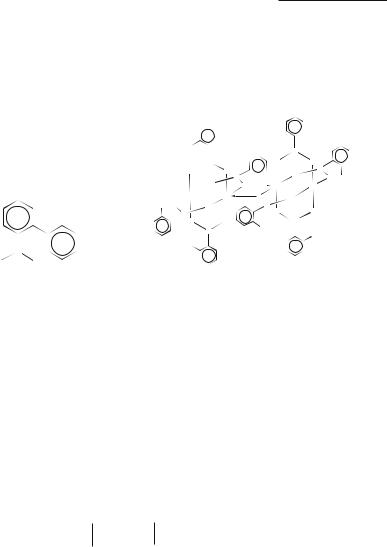
Chromium Compounds 41
Cotton
with the object of obtaining unassociated, uncoordinated molecules. However, an unanticipated result was obtained, as shown schematically in 3.2. In each of two Cr2(O2Cbiph)4 molecules, all pendant phenyl groups have oriented themselves to one end, thus preventing the use of oxygen atoms on that end for association. The unencumbered ends of the two Cr2(O2Cbiph)4 molecules, however, have united, to produce a dimer.
|
|
|
|
|
|
|
Ph |
Ph |
|
Ph |
|
|
|
C |
|
|
|
|
|
|
|
||
|
CH |
|
|
|
|
|
|
|
|
|
|
O |
O |
||
O |
|
O |
|
|
|
O |
C |
|
O |
C |
|
|
|
O Ph |
|
|
O |
|
|
|
|
|
|
|
|
|
|
CR |
Cr |
||
Cr |
|
CR |
O |
|
|
O |
|
|
|
|
|
||||
Ph O |
|
|
|
|
|
|
|
O |
|
|
C |
O |
|||
C |
|
|
|
|
O |
||
O |
|
O |
|
|
|
CH |
|
|
C |
|
|
Ph |
Ph |
||
|
|
|
|
|
|
||
|
|
|
|
|
|
|
|
Ph
C
O  O
O
3.1 |
3.2 |
In another early effort36 to obtain a crystalline sample of a Cr2(O2CR)4 compound having no axial ligation the group R was chosen to be triphenylmethyl, Ph3C, and the compound was crystallized from benzene. Once again, the desired goal was not achieved because of the enormous avidity of Cr2(O2CR)4 compounds for some kind of axial ligation. In Cr2(O2CCPh3)4·C6H6, the steric requirements of the large CPh3 groups lead to a tetragonal packing of the molecules in which there are parallel infinite chains of the type shown schematically in 3.3, with a benzene molecule centered between every neighboring Cr pair, perpendicular to the chain direction. The Cr–Cr distance within each Cr2 unit, 2.256(4) Å , the shortest one yet found in any crystal-
line Cr2(O2CR)4L0,1,2 type compound, is still relatively long. MO calculations36 show that the reason for this lengthening is that the benzene molecules donate electron density from their
filled /-orbitals (e1) to the /*-orbitals of the Cr2 units. This was the first recognized case of donation to the /* rather the μ* orbitals.
Cr |
|
Cr |
Cr |
|
Cr |
Cr |
|
Cr |
|
|
|
||||||
|
|
|
|
|
|
|
|
|
 6.6 Å
6.6 Å
3.3
Two similar compounds with p-C6H4F2 and p-C6H4(CH3)2 were also examined.36 They are essentially isostructural with Cr2(O2CCPh3)4·C6H6. The results of substituting axial / donors that are less and more electron-donating than benzene, are qualitatively exactly what would be expected. In the p-C6H4F2 compound the Cr–Cr bond is shorter, 2.176(3) Å, and in the p-C6H4(CH3)2 compound it is longer, 2.291(3) Å.
While the crystallographic approach to determining the length of a Cr–Cr bond in a Cr2(O2CR)4 molecule entirely lacking axial ligation remained at this time a failure, another general approach, that of examining a molecule in the gas phase, was pursued successfully.37 It had long been known that some Cr2(O2CR)4 compounds are moderately volatile38 (mass spectra display parent ion peaks). The gas-phase structure would have to be determined by electron diffraction, thus requiring that the subject molecule be small; only the formate and the acetate are small enough to meet this criterion, and the formate is thermally unstable. It is also neces-

42Multiple Bonds Between Metal Atoms Chapter 3
sary that there be a sufficient vapor pressure at a temperature where no decomposition products whatsoever are formed because these would contribute to (and vitiate) the measured diffraction pattern. It was finally found that the acetate can be used, provided it is handled in a system that excludes all contact of the vapor with metal surfaces. At metal surfaces decomposition occurs.
Even with the relatively simple acetate molecule, deconvolution of the radial distribution function to reveal the Cr–Cr distance in the presence of many others of similar magnitude was a process requiring the expert application of the most sophisticated methods. The end result37 was the determination of the Cr–Cr distance as 1.966(14) Å. Despite the technical difficulty of the work, this is a reliable result, although unfounded doubts had been expressed.
Finally, in 2000, the quest for an X-ray characterized Cr2(O2CR)4 compound in which there is no axial ligation of any kind was rewarded.39 The compound is shown in Fig. 3.5. The R group is 2,4,6-triisopropylphenyl. The Cr–Cr bond length is 1.9662(5) Å. This, it may be noted, perfectly confirms the report based on electron diffraction in the vapor phase of 1.966(14) Å for the acetate. It was also shown that the addition of axial ligands greatly lengthens the Cr–Cr bond, to 2.3892(2) Å for the Cr2(O2CR)4(NCCH3)2 compound. (This is almost identical to the Cr–Cr distance in Cr2(O2CCH3)4(NCCH3)2.
Fig. 3.5. The molecular structure of the molecule Cr2(O2CR)4, R = 2,4,6-tri-iso- propylphenyl.
Prior to the experimental study of Cr2[O2C(2,4,6-Pri)3C6H2]4 there had been considerable theoretical discussion as to whether the axial or the equatorial ligands had the greater influence on the Cr–Cr bond length.40-43 There was decidedly much to be said in favor of the former, but theorists espoused the latter, basing themselves on the results of Hartree-Fock calculations. There is no longer any point in recounting this controversy because one good experiment39 has definitively resolved it. For those interested, however, Chapter 4 of the 2nd edition of this book may be consulted.
There are two striking facts about the data in Table 3.1. One is that the range of Cr–Cr distances is large and the other is that even the shortest ones where axial ligands are present are much longer than the longest Mo–Mo quadruple bond length. In 1984 a systematic effort was made to see if the Cr–Cr distances could be correlated with axial ligand basicity when the bridging RCO2- ion was kept constant, or with the strength of the acid. Qualitative correlations of both these types were found,44 as well as an inverse relationship between Cr–Cr distance and axial Cr–N distance for various substituted pyridines.
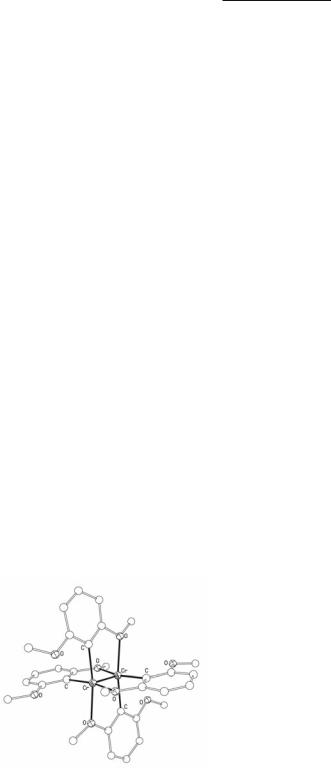
Chromium Compounds 43
Cotton
The heteronuclear compound CrMo(O2CCH3)4 was made45 by reaction of Mo(CO)6 with acetic acid in the presence of excess Cr2(O2CCH3)4 (Cr/Mo ratio of c. 5). It was the first authenticated compound containing a heteronuclear quadruple bond, although others have since been made. The most interesting thing about this compound is the length of the Cr–Mo bond, 2.050(1) Å, in comparison with the Cr–Cr and Mo–Mo bond lengths in the homonuclear acetates, which are 1.966(12) and 2.093(1) Å, respectively. This indicates that when the chromium atom is bonded to a molybdenum atom, rather than to another chromium atom, and no axial ligands are present, it manifests the bonding capabilities that might have been expected of it, since the Cr–Mo bond is shorter than the Mo–Mo bond, but longer than the Cr–Cr bond, by about the expected difference of the Cr and Mo atomic radii. The reason for this behavior has been explored by ab initio molecular orbital calculations.46 It is found that the Cr–Mo interaction leads to orbital populations essentially similar to those in the Mo–Mo case, but very different from those in the Cr–Cr case.
3.2Other Paddlewheel Compounds
3.2.1 The first ‘supershort’ bonds
As noted in Section 1.4, a major role in the growth of the field of quadruply bonded M–M compounds has been played by bridging ligands that are stereoelectronically similar to the carboxylate ions. Nowhere has this been more important than for the dichromium compounds. Prior to the preparation of the first compound containing such a ligand, the only large class of quadruply bonded Cr2 compounds was the carboxylates, mostly Cr2(O2CR4)L2 compounds with rather long and remarkably sensitive Cr–Cr bonds, that vary through the range of 2.2-2.6 Å. There are also a few organodichromium compounds, to be discussed in Section 3.3, in which Cr–Cr distances are in the range of 1.95-2.00 Å. It was not clear, however, whether these latter highly air-sensitive and poorly characterized compounds had any broad significance or were only isolated curiosities.
It was the preparation and characterization of Cr2(DMP)4, (DMP = 2,6-dimethoxyphenyl) whose structure is shown in Fig. 3.6 that initiated the development of a broad, systematic chemistry of dichromium compounds with very short, unmistakably quadruple bonds. At the time it was discovered,47,48 the Cr–Cr bond distance of 1.847(1) Å in Cr2(DMP)4 was considered so surprisingly short as to raise the question of whether there might, somehow, be an error in the structure determination. This was recognized to be exceedingly unlikely, since every phase of the crystallographic structure determination on Cr2(DMP)4 had proceeded routinely.
Fig. 3.6. The molecular structure of Cr2(2,6-dimethoxyphenyl)4, Cr2(DMP)4.

44 Multiple Bonds Between Metal Atoms
Chapter 3
There had been no indication of twinning, disorder, or the like, the other bond lengths and angles were all normal, and, in general, a crystal structure determination is so overdetermined mathematically (data-to-parameter ratio typically 5/1 or higher) that major error is almost inconceivable. Nonetheless, to be fully certain that no subtle, unrecognized error had crept in, the structure of the chemically almost identical compound, Cr2(TMP)4, where TMP is the 2,4,6-trimethoxyphenyl anion, was determined.48,49 This molecule affords a crystal structure that is totally independent of the Cr2(DMP)4 structure, and thus provides a totally separate and independent measurement of the Cr–Cr distance. The result was 1.849(2) Å, which is statistically indistinguishable from that for Cr2(DMP)4.
Cr2(DMP)4 and Cr2(TMP)4 were rather easily prepared by the reactions:
|
|
|
X |
|
|
|
|
Cr2(O2CCH3)4 + 4Li |
|
OMe |
|
|
Cr2(DMP)4 or Cr2(TMP)4 |
||
|
MeO |
|
|
||||
|
|
|
|
|
|||
|
|
|
|
|
|
|
|
|
|
DMP, X = H |
|||||
|
|
TMP, X = OMe |
|||||
Both compounds are beautifully crystalline orange-red solids that can be handled in air for several minutes without decomposition, although solutions are immediately attacked by air. Surprisingly, the solid Mo2(DMP)4 analog is extremely sensitive to oxygen.
The Cr–Cr bonds in Cr2(DMP)4 and Cr2(TMP)4 are extraordinarily short compared to any other known metal-metal bonds, but to go beyond a mere qualitative comment of this kind and make a quantitative comparison, not only with other M–M bonds but with all other bonds, a scheme that takes account of the inherent sizes of the atoms in a bond is needed. For example, it is not surprising that a C–C bond is shorter than an Si–Si bond because carbon atoms are smaller than silicon atoms. On the other hand, the fact that the P–P distance in the P2 molecules (1.89 Å) is far shorter than the usual Si–Si distance (2.34 Å) is highly significant, since the P and Si atoms are not expected to differ much in intrinsic size. The significance, of course, is that we are comparing a triple bond, P>P, with a single bond.
A convenient, broadly applicable set of ‘atomic sizes’ is provided by the set of R1 radii worked out many years ago by Pauling.50 The meaning of the absolute values of these radii is irrelevant so long as they afford a correct measure of the relative sizes of the atoms, which they do. We then define a ‘formal shortness ratio’, FSR, for a bond A–B as follows:
FSRAB = |
|
DA-B |
|
R |
A + R B |
||
|
|||
1 |
1 |
||
The FSR for the Cr–Cr bond in Cr2(DMP)4 is found to be 1.847/(2×1.186) = 0.779, while those for the Cr–Cr and Mo–Mo bonds in the unsolvated acetates are 0.965 and 0.807, and that for the Re–Re bond in [Re2Cl8]2- is 0.869. Thus we see that when due allowance is made for the inherently smaller size of the chromium atom, the Cr–Cr bond in Cr2(DMP)4 is exceptionally short even when compared to other quadruple bonds. We shall return to this point later, but first we describe several other dichromium compounds with even shorter bonds.
Examination of the structure of Cr2(DMP)4 shows that while one methoxy oxygen atom on each DMP ligand is essential because it is coordinated to a chromium atom, the other one appears to be superfluous. The question thus arises whether a comparable compound could be obtained with the 2-methoxyphenyl ion, 3.4, derived from anisole. In fact, Cr2(2-MeOC6H4)4 had already been reported, twice,51,52 but never well characterized.
